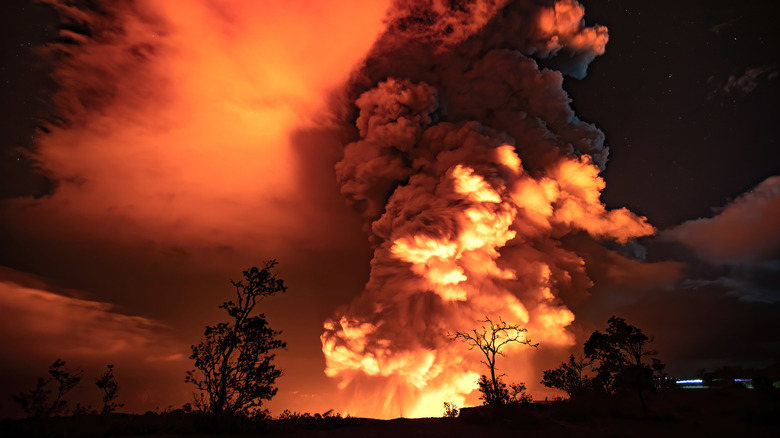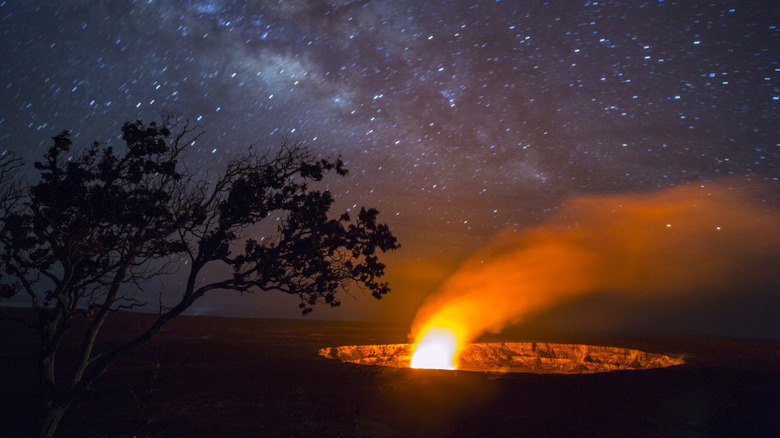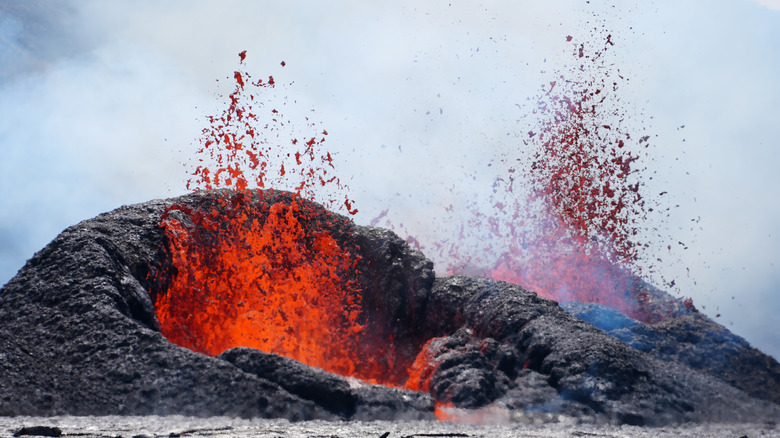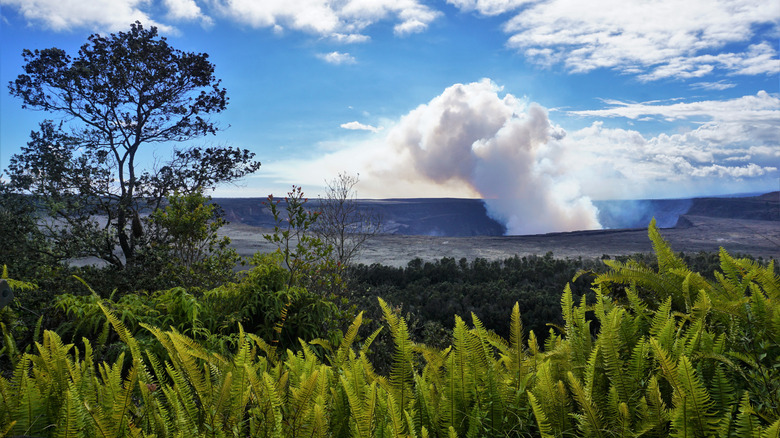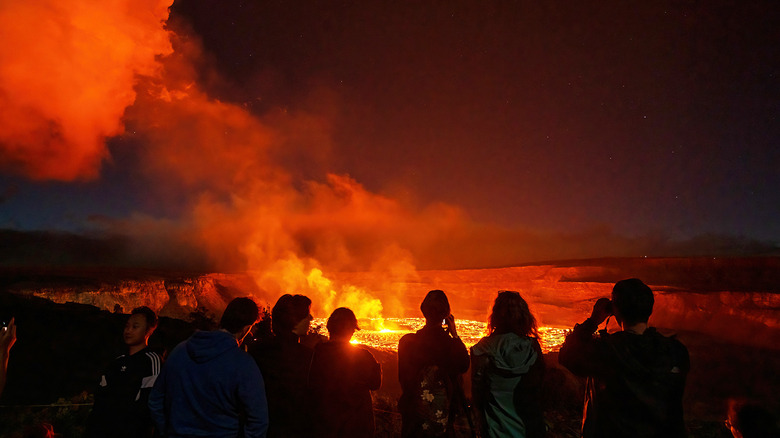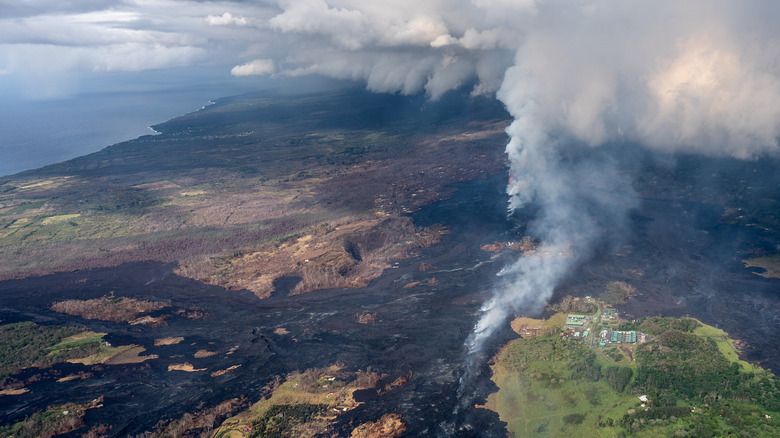The Hawaiian Volcano That's Barely Stopped Erupting Since 1983
Few places on Earth demonstrate the raw power of geological activity like volcanoes. The dynamic processes beneath our planet's crust are the reasons behind (or rather, under) events like the July 2024 Yellowstone Biscuit Basin explosion, serving as reminders that even dormant volcanic regions hold immense potential for upheaval and even disaster. One volcano, Hawaii's Mount Kilauea, has long held the curiosity of scientists and those who have lived near it for thousands of years.
A shield volcano, Kilauea is a low, sloping type of volcano that resembles a horizontal shield. The volcano has been intermittently active for the last 2,000 years, with perhaps its most notable eruption in the last several centuries starting in 1983, and only coming to a dramatic end in 2018. That event, known as the Pu'u'ō'ō Eruption, produced enough lava to cover an area of 60 square miles, destroyed and damaged hundreds of homes, and even added new coastline to Hawaii Island. That last fact might be the best way to encapsulate just how powerful volcanoes are — they can literally create "new Earth."
Since 2018, the volcano has gone through periods of eruptions both big and small, as well as times of relative quiet. But on September 15, 2024, Mount Kilauea erupted with renewed intensity, covering 156 acres of land in lava from a fissure stretching over a mile in length in an event that the United States Geological Survey (USGS) called "a significant and fascinating change in activity at Kilauea." And recent earthquake activity since that eruption might also indicate a coming disaster. With Kilauea waking up again, scientists are taking an in-depth look at the volcano's history to see what they can learn about its potential future.
Kilauea in Hawaiian culture and early records
Mount Kilauea holds a significant place in the scientific record and local Hawaiian culture. For Hawaiians, Kilauea is sacred, a physical manifestation of Pele (or Pelehonuamea), the goddess of volcanoes and fire. In Hawaiian mythology, Pele created the Hawaiian islands through her fiery eruptions, and the Halemaʻumaʻu crater at Kilauea's summit is her abode. Though oral traditions vary somewhat, most recount how her lava flows shaped the land as both a destructive and creative force and how communities lived in reverence of her power, understanding the importance of living in harmony with the natural forces around them.
The modern scientific record of Kilauea dates back to the early 19th century, but by using isotopic data as a proxy for volcanic activity, there is evidence of eruptions happening as far back as 4,650 B.C. The start of our scientific knowledge base about the mountain is attributed to William Ellis, an English missionary who visited the volcano on August 1, 1823. Ellis would later publish a book of his observations, which constitute the first contemporary recordings scientists have of Kilauea's eruptions.
Over time, Kilauea gained international attention as one of the world's most active volcanoes. The early 20th century saw the establishment of the Hawaiian Volcano Observatory in 1912, the first organization in the country dedicated to monitoring volcanic activity. The observatory owes much of its existence to geologist Thomas A. Jagger, who in 1916 said (via USGS) of the region, "There is no place on the globe so favorable for systematic study of volcanology and the relations of local earthquakes to volcanoes as in Hawaii."
Kilauea's prolonged eruption: 1983 - 2018
For over three decades, Kilauea held the distinction of being one of the longest continuously erupting volcanoes in recorded history. Beginning on January 3, 1983, the Pu'u'ō'ō Eruption would radically reshape Hawaii Island over the course of the next 35 years, producing 1.1 cubic miles of lava and adding 439 acres of coastline to the island's southeastern shore when all was said and done. Though scientists describe the eruption as "continuous," the eruption actually took hundreds of breaks in its lifespan where surface activity came to a halt, ranging from a few hours to nearly a month at a time.
Finally, on April 30, 2018, Kilauea's Pu'u'ō'ō summit spectacularly collapsed, marking the end of the three-and-a-half-decade-long eruption. All told, 215 buildings and other structures had been destroyed, and nearly 9 miles of highway were buried under as much as 115 feet of lava. Two days later, Kilauea's lava lake began to lower as magma drained away from the mountain via underground pathways.
The island would get little respite, however. Just as the 35-year eruption came to an end, another began. On May 3, 2018, an eruption fissure opened in the Leilani Estates subdivision, a residential area of the island. Compared to the long, slow burning of the Pu'u'ō'ō Eruption, Kilauea's 2018 eruption was a violent and geologically brief affair, lasting only a few months but producing 24 volcanic fissures, 60,000 earthquakes, and covering 13.7 miles in lava, while adding another 875 acres of new land to the island's shoreline.
The 2018 eruption aftermath and Kilauea's 2020 reawakening
The 2018 eruption of Kilauea left an indelible mark on Hawaii Island. Over four months, volcanic activity destroyed more than 600 residences and displaced thousands. Entire communities, such as the Kapoho and Lanipuna Gardens neighborhoods, were wiped off the map. The recovery process has been slow and painstaking ever since, with federal and state agencies working to help displaced residents make difficult decisions about whether or not to return and try to rebuild lost neighborhoods. Since the eruption, some have chosen to do just that, rebuilding their homes on top of the very lava that destroyed their old ones.
Despite the wide-ranging devastation, scientists and emergency responders learned to leverage social media and airborne drones to assist those in the lava's path during the disaster, increasing response times and potentially saving lives in the process. Because of this, the eruption represented a useful case study into volcano disaster response and a blueprint for communities living near the hundreds of active (and potentially active) volcanoes in the United States.
After a two-year lull, Kilauea reawakened in December 2020 with a new eruption at Halemaʻumaʻu crater, an event that was marked by the sudden appearance of a lava lake at the mountain's summit. The eruption continued into early 2021, contributing to the reshaping of the crater and providing scientists with more insights into the behavior of magma reservoirs following large eruptions.
Kilauea's 2023 and 2024 resurgence
In early 2023, geologists at the Hawaiian Volcano Observatory noticed an increase in earthquake activity and ground deformations around Kilauea's Halemaʻumaʻu crater. On January 5, that activity culminated in large explosions and lava fountains shooting 164 feet in the air. These fountains would produce a lava lake big enough to fill roughly 2% of the caldera after its massive 2018 collapse, according to the United States Geological Service. The eruption came to a halt 61 days later, a period during which thousands of visitors were drawn to Hawaii Volcanoes National Park to watch the lava lake's post-sunset glow.
The January eruption was also so potent that, upon Kilauea's 2023 reawakening, nearby shield volcano Mauna Loa ceased erupting. Connected to the same underground hotspot system, scientists believe the two volcanoes are linked in some way, as when one is active, the other tends to be quiet.
Several eruption events took place on Kilauea in 2023. But on June 3, 2024, after nearly a year of geological calm, a fissure eruption occurred in a remote area of Hawaii Volcanoes National Park, roughly 2.5 miles southwest of Kilauea caldera. While the eruption was located in a part of the park that was not open to visitors, early-morning hikers were able to see a reddish lava glow in the sky before dawn from the park's Crater Rim Trail. The event was significant in that it was the first eruption to take place in Kilauea's Southwest Rift Zone since 1974, renewing scientific interest in an area of the mountain that is often overshadowed by events in the East Rift Zone (the site of the Pu'u'ō'ō and 2018 eruptions).
Looking ahead: Kilauea's future
With a small eruption occurring on September 15, 2024, and observations of increased earthquake activity on Kilauea as of December 9, scientists are on the lookout for the volcano's next move, as such seismic unrest highlights the ongoing unpredictability of one of the world's most active volcanoes.
The location of the Hawaiian Volcano Observatory itself speaks to this volatility. Having sat perched on the rim of Kilauea's summit caldera for much of its history, following the aftermath of earthquakes and ash explosions during the mountain's vehement 2018 eruption, the observatory moved 30 miles away to a safe distance. Since its establishment in 1912, the observatory's team now includes specialists in numerous disciplines like geology, seismology, and volcanic gases who utilize a range of geophysical instruments, radio systems, and public communications tools to keep people safe and informed.
For the residents of Hawaii Island, this research isn't just interesting; it's critical to their survival and a continuation of the mythology of Pele's presence in the world. And as Kilauea's story continues to unfold, it remains both a natural wonder and an invitation for scientists who seek to understand it.
If you're interested in learning more about how volcanoes form, check out our guide on the difference between the Earth's crust and the lithosphere and what drives the process of plate tectonics.
